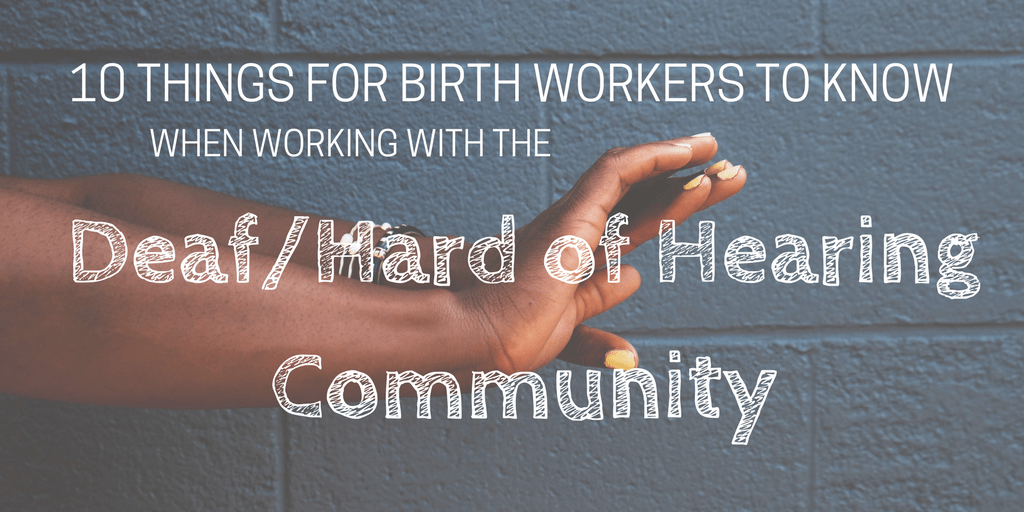10 Things for Birth Workers to Know when Supporting the Deaf/Hard of Hearing Community
Guest post by Sariah Price of Heart to Hands Doula Services
Seventeen years ago, when my first child was born, I had no idea that his birth would lead me to learn a new language, meet some really amazing people and come to love a whole new culture. When my son was 16 months old we found out that he was moderately to severely Deaf. This information gave our family the wonderful opportunity to learn American Sign Language.
Three and a half years ago, I became a Doula and with my fluency in American Sign Language, I have had the blessing to support several Deaf families. For the most part, birth is birth, weather you are Deaf or hearing, but here are some unique differences that I hope will help you support a Deaf or Hard of Hearing client.
- Lighting: Lighting is SO important. As a hearing person, I rely on background and environmental sounds for context and social cues, which means lighting can be low, yet I still have the ability to communicate effectively. On the other hand, a Deaf client relies heavily on their vision for communication, context and social cues, so, proper lighting is very important.
- Visual Field: For me, a hearing person, I don’t need to see your face in order to communicate with you. But a Deaf client must have face to face communication. If they can’t SEE you, then they cannot understand you.
A Deaf client must have face to face communication. If they can’t SEE you, then they cannot understand you.
- Working with an Interpreter: Some Deaf clients will hire an interpreter and that is great. For you this means making room for the interpreter to be face to face with your client. It means speaking directly to your client and not to the interpreter.
- Facial Expressions/Body Language: Facial expressions and body language are a very important part of American Sign Language. Did you know that in 1972 Dr. Albert Mehrabian published a book called, “Nonverbal Communication”? In this book, he broke down typical spoken communication into three categories; spoken words (7%), tone of voice (38%), and body language (55%). In American Sign Language, the percentage for body language is much higher. What we say with our facial expressions and body language are easily and quickly deciphered by Deaf people, because these are such an integral part of American Sign Language.
- Dress: What you wear can have a great effect on your client. If you wear a shirt with lots of bold bright colors or a shirt with abstract/crazy patterns, your Deaf client will find it very hard to focus on you without becoming distracted or fatigued. Imagine if you had to look at bold bright colors or crazy patterns all day. Your eyes would fatigue quickly and you would have a difficult time wanting to look in that direction. Please stick to solid, not too bright, shirts. Your Deaf client will appreciate this.
- Cochlear Implants/Hearing Aids: Some people in the Deaf community have a Cochlear implants or hearing aids and some do not. Most of the time, at least for the clients I have worked with, these devices are not worn during labor, but they may want them on as soon as baby is born. Having them off helps to tune out the world and focus on the task at hand.
- Lip Reading: Some Deaf do, and some Deaf do not lip read. It is not a universal skill that everyone in the Deaf community has. If you are working with someone who prefers to lip read, and you know this because they have told you, PLEASE DO NOT change the way you move your lips and DO NOT over enunciate. This will make it nearly impossible to read your lips.
- Texting/ Video Relay/ Paper & Pen: There are many ways for the hearing and Deaf communities to communicate directly. Most Deaf people love to text or instant message. Some prefer video relay. Video relay is a service where a hearing person can call a relay center and an American Sign Language interpreter will video relay the interpreted call. And lastly there is good old paper and pen. Because most Deaf people have grown up and have been educated here in the United States, they can read and write in English fairly well. Do not let the lack of an interpreter stop you from communicating with people in the Deaf community. As a community, they will appreciate your efforts to communicate with them.
Do not let the lack of an interpreter stop you from communicating with people in the Deaf community. As a community, they will appreciate your efforts to communicate with them.
- American Sign Language/ S.E.E. Sign/ Total Communication: Not all signs are created equal. American Sign Language is an official language, with its own rules, syntax and grammar. S.E.E. Sign, stands for Signing Exact English. S.E.E. Sign uses a sign or gesture for each English word. S.E.E. Sign is not a language but has been used to teach English to deaf or hard of hearing children. Total Communication uses American Sign Language signs at the same time as spoken English. This is hard to do and be true to both English and ASL. Find out which method your client prefers and then try to learn a bit in that method. They will appreciate your efforts.
- Big “D” Deaf: As you may have noticed, when I refer to the Deaf community, I always capitalize the “D”. Deaf (with a capital “D”) refers to embracing the cultural norms, beliefs, and values of the Deaf Community. Not everyone who uses American Sign Language claims to be Deaf. If you are not sure, just ask.
I teach a six week ASL course for birth workers. This class covers commonly used birth terms. If you are interested, please feel free to contact me for the dates of up-coming classes.
Sariah Price received her doula training through DONA International. She has experience with home birth, hospital induction, epidurals, non-medicated, hypnobirthing, and c-sections. Sariah’s goal as a doula is to support, encourage, educate and enable her clients as they bring new life into this world.
https://hearttohandsdoulaservices.blogspot.com https://www.facebook.com/HandsToHeartDoula


